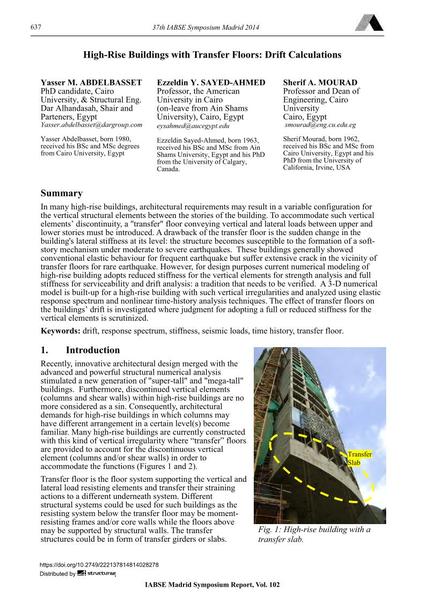High-Rise Buildings with Transfer Floors: Drift Calculations

|
|
|||||||||||
Détails bibliographiques
| Auteur(s): |
Yasser M. Abdelbasset
Ezzeldin Y. Sayed-Ahmed Sherif A. Mourad |
||||
|---|---|---|---|---|---|
| Médium: | papier de conférence | ||||
| Langue(s): | anglais | ||||
| Conférence: | IABSE Symposium: Engineering for Progress, Nature and People, Madrid, Spain, 3-5 September 2014 | ||||
| Publié dans: | IABSE Symposium Madrid 2014 | ||||
|
|||||
| Page(s): | 637-644 | ||||
| Nombre total de pages (du PDF): | 8 | ||||
| Année: | 2014 | ||||
| DOI: | 10.2749/222137814814028278 | ||||
| Abstrait: |
In many high-rise buildings, architectural requirements may result in a variable configuration for the vertical structural elements between the stories of the building. To accommodate such vertical elements’ discontinuity, a "transfer" floor conveying vertical and lateral loads between upper and lower stories must be introduced. A drawback of the transfer floor is the sudden change in the building's lateral stiffness at its level: the structure becomes susceptible to the formation of a soft- story mechanism under moderate to severe earthquakes. These buildings generally showed conventional elastic behaviour for frequent earthquake but suffer extensive crack in the vicinity of transfer floors for rare earthquake. However, for design purposes current numerical modeling of high-rise building adopts reduced stiffness for the vertical elements for strength analysis and full stiffness for serviceability and drift analysis: a tradition that needs to be verified. A 3-D numerical model is built-up for a high-rise building with such vertical irregularities and analyzed using elastic response spectrum and nonlinear time-history analysis techniques. The effect of transfer floors on the buildings’ drift is investigated where judgment for adopting a full or reduced stiffness for the vertical elements is scrutinized. |
||||
| Mots-clé: |
charges sismiques
|
||||
